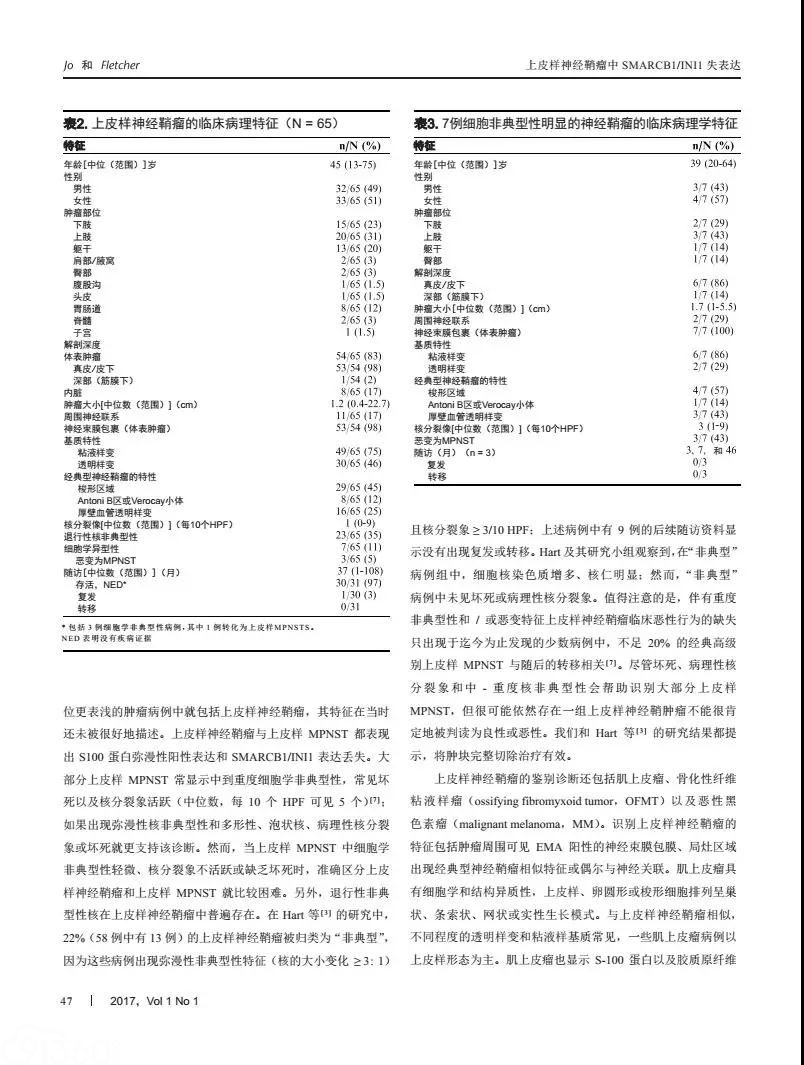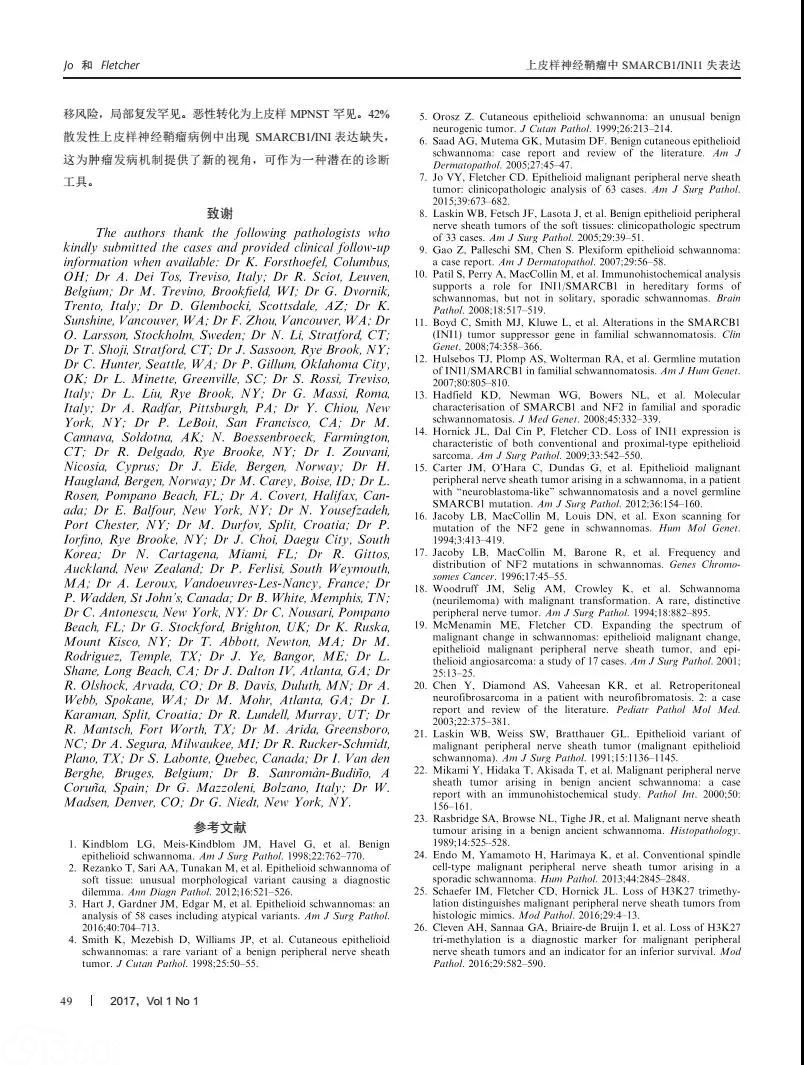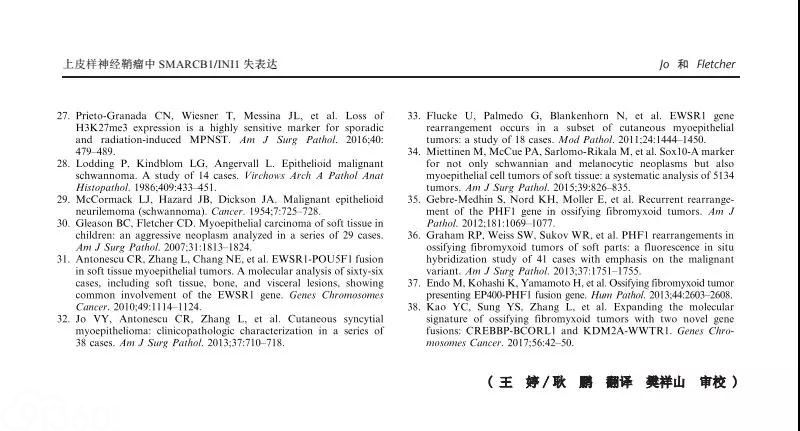上皮样神经鞘瘤较为罕见,据报道,部分病例缺乏SMARCB1/INI1表达。本研究旨在进一步明确该病的临床病理特征并评估SMARCB1/INI1表达缺失情况。我们纳入2002年至2015年期间65例被诊断为“上皮样神经鞘瘤”的患者,中位年龄45岁(范围:13岁~75岁),其中32名男性,33名女性。肿瘤好发于四肢(上肢20例,下肢15例)和躯干(17 例);9例原发于内脏(胃肠道8例)。大多数发生于体表的肿瘤位于真皮/皮下(54例中的53例),呈包裹性(54例中的53例)生长,其中46例由上皮膜抗原(epithelial membrane antigen,EMA)阳性的神经束膜包裹;位于内脏的肿瘤常为非包裹性的。所有患者否认神经嵴疾病史。3例患者有多发病变(且每例均为2处病灶)。肿瘤大小为0.4cm~22.7cm(中位数,1.2cm)。肿瘤由均匀一致的上皮样细胞组成,分叶状生长,呈片状、巢团状或者单个散在分布,常常伴有粘液样或玻璃样变间质。肿瘤细胞具有圆形、泡状细胞核和丰富、淡染的嗜酸性细胞质,通常缺乏显著的多形性或核深染现象。一些肿瘤显示类似于普通神经鞘瘤的区域(梭形区域,29例;Antoni B区或Verocay小体,8例;玻璃样变的厚壁血管,16例)。每10个高倍视野(high-power fields,HPF)下可见0到9个核分裂(中位数,1个)。所有病例均未见肿瘤性坏死。23例显示退变的非典型性核/异型核。7例肿瘤示明显的细胞非典型性,其中3例转化为上皮样恶性外周神经鞘膜瘤。所有肿瘤均显示S-100蛋白弥漫阳性和SOX10一致阳性(50例全部),而57例中的24例显示INI1表达缺失。其他阳性的免疫组织化学结果包括:神经胶质纤维酸性蛋白(37例中有15例)、局灶表达角蛋白(40例中有2例);上皮膜抗原(53例中无1例)和黑素细胞标记均为阴性(Mart-1,29例中无1例;HMB-45,23例中无1例)。大多数患者接受了局部切除术(13例完全切除;47例切缘阳性)。31例患者的随访数据(随访时间范围:1~108月,中位随访时间37月),显示,无1人出现肿瘤转移,包括3例细胞学具有非典型性的病例,其中1例显示恶性转化。1例无细胞学非典型性的肿瘤患者在边缘切除术后局部复发,其他所有患者均无病生存。上皮样神经鞘瘤最常表现为成人肢端或躯干的浅表肿瘤。42%病例缺乏SMARCB1/INI1表达。复发和恶性转变不常发生,肿瘤总体上呈良性临床进展。一些肿瘤具有显著的细胞异型性,这一点所对应的临床意义尚不明确,形态学上可能与低级别上皮样恶性外周神经鞘瘤有延续性。
来源:Am J Surg Pathol 2017;41:1013–1021
美国外科病理学杂志中文版2017年第一期全文No.5
(王婷/耿鹏 翻译;樊祥山 审校)




The American Journal of Surgical Pathology 中文版声明:
2017 American Journal of Surgical Pathology and Wolters Kluwer Health
The material is published by Wolters Kluwer Health with the permission of American Journal of Surgical Pathology.No part of this publication may be reproduced in any form,stored in a retrieval system or transmitted in any form,by any means,without prior written permission from Wolters Kluwer Health.Opinions expressed by the authors and advertisers are not necessarily those of the American Journal of Surgical Pathology, its affiliates,or of the Publisher.The American Journal of Surgical Pathology,its affiliates,and the Publisher disclaim any liability to any party for the accuracy,completeness,efficacy,or availability of the material contained in this publication (including drug dosages) or for any damages arising out of the use or non-use of any of the material contained in this publication.
Although advertising material is expected to conform to ethical (medical) standards,inclusion in this publication does not constitute a guarantee or endorsement of the quality or value of such product or of the claims made of it by its manufacturer




 苏公网安备 32011402011742
苏公网安备 32011402011742